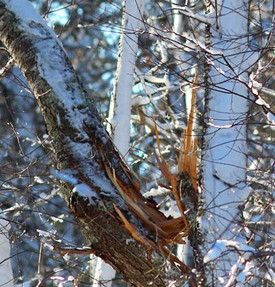 When Mother Nature does the pruning, her saw is the delicate white snowflakes that fall so softly. But they pack a big punch, for she really is the iron hand in the velvet glove.
When Mother Nature does the pruning, her saw is the delicate white snowflakes that fall so softly. But they pack a big punch, for she really is the iron hand in the velvet glove.
Storms are this old Ma’s way of pruning and she barely lifts a finger. An unfeeling parent, she simply disposes of the old, the weak and the imperfect to make space for new plants, which teaches us a tough lesson.
Understanding why trees and shrubs break during snow and ice storms is the first step towards preventing future damage.
Quite simply, it is when the weight on the ends of branches or bent tops is more than the tensile strength of frozen stems and trunks can bear, they break. Or they bend. It’s worse on fine-twigged plants like azalea and dogwood because the close growing twigs hold more snow and therefore more weight.
Try to remember where snow covered branches were bent to the ground, for those are the branches that need to be shortened or lightened when the careful spring pruning is done. Write it down or take a picture to keep the memory fresh.
For now, let the warm rain and sun gently melt off the snow and ice, drop by drop. A few warm days will get the sap running (temporarily at least) and give stems a chance to spring back upright. They may not recover all at once, but gradually they will come upright.
The way to loosen branches and plants bent and stuck in the melting snow is to gently loosen the end and raise it just enough to get the snow off. Often it will spring up. Maybe shake the end gently. But never do it with a shovel.
 Remember that when plant parts are frozen solid, they’re very fragile, like brittle glass. You can cut off any badly broken parts now. But finish any fine pruning later, in spring, after the plants have come back upright.
Remember that when plant parts are frozen solid, they’re very fragile, like brittle glass. You can cut off any badly broken parts now. But finish any fine pruning later, in spring, after the plants have come back upright.
Also wait until spring, and then stake the trees that need to be straightened. Be sure to use a protective piece of hose over the wire around the trunk to prevent stripping the bark. Shrubs can be gently staked and tied up with string until after they bloom in spring, then pruned.
Broken off branches of early bloomers like forsythia and cherry can be brought indoors now and forced into bloom, however later blooming varieties like dogwood and crabapple will be less successful this early in the season.
For seriously damaged trees, call a Certified Arborist to assess the damage and the tree’s future growth potential. Don’t let just anyone with a power saw hack away at your storm damage.
A properly trained arborist can often salvage a hurt tree. Also dangerous trees and limbs can be identified and corrected. Sometimes a tree that looks like a goner can be helped by bracing or wiring, especially high in the crown. Expert pruning can restore the center of gravity to an unbalanced tree, or lighten the load so it will better withstand the next storm.
So what is a groaning gardener to do when viewing the tree and shrub breakage after a really heavy snowstorm? One can ponder the cleanup required OR one can celebrate the many (albeit minor) holidays of winter!
I prefer to celebrate. So this winter, eat chocolate while waiting for Mother Nature to straighten up her snowy, pruning mess.
Ruth S. Foster is a landscape consultant and arborist. More gardening
information can be found on her website, www.mothersgarden.net.
Credit: www.mothersgarden.net




























